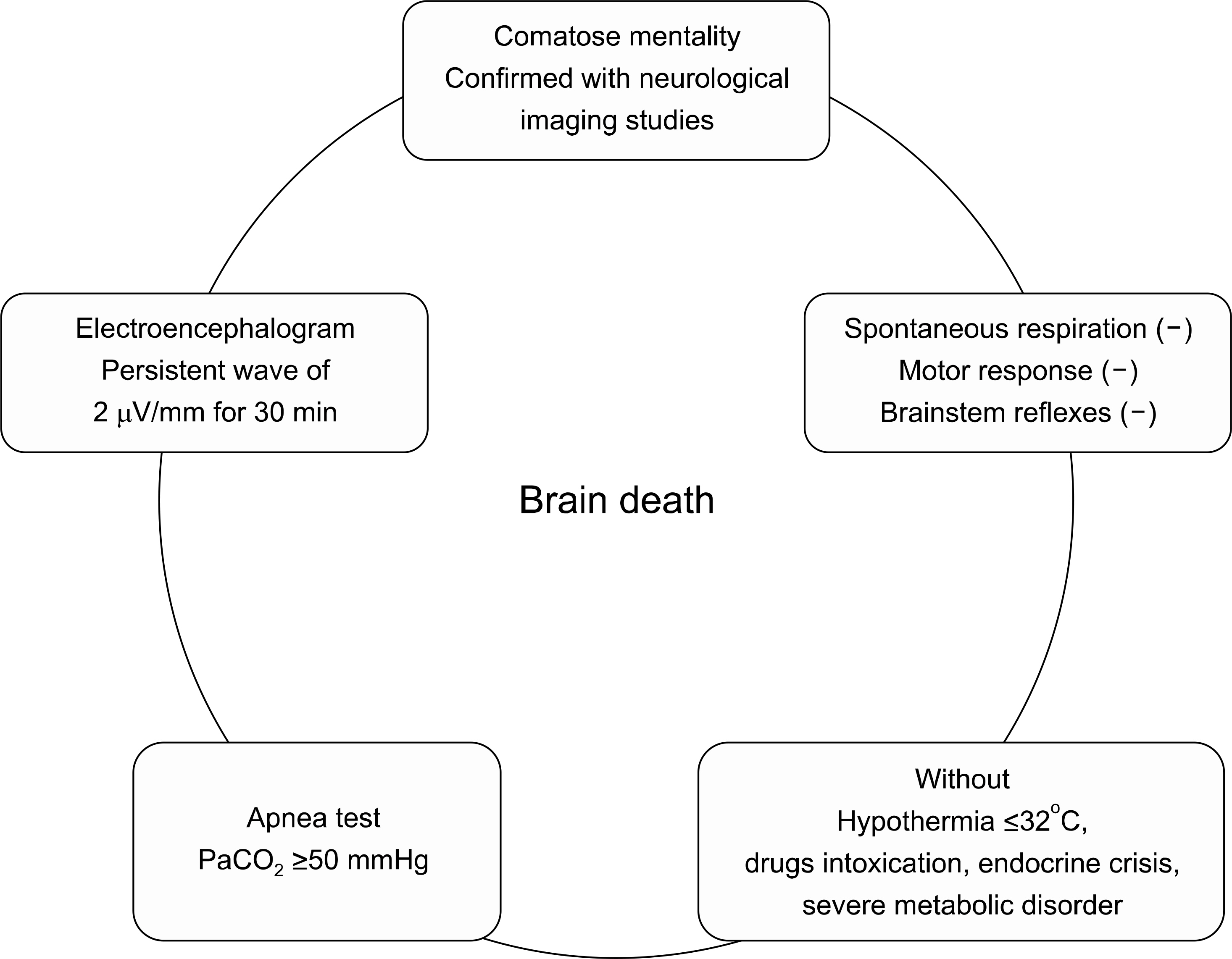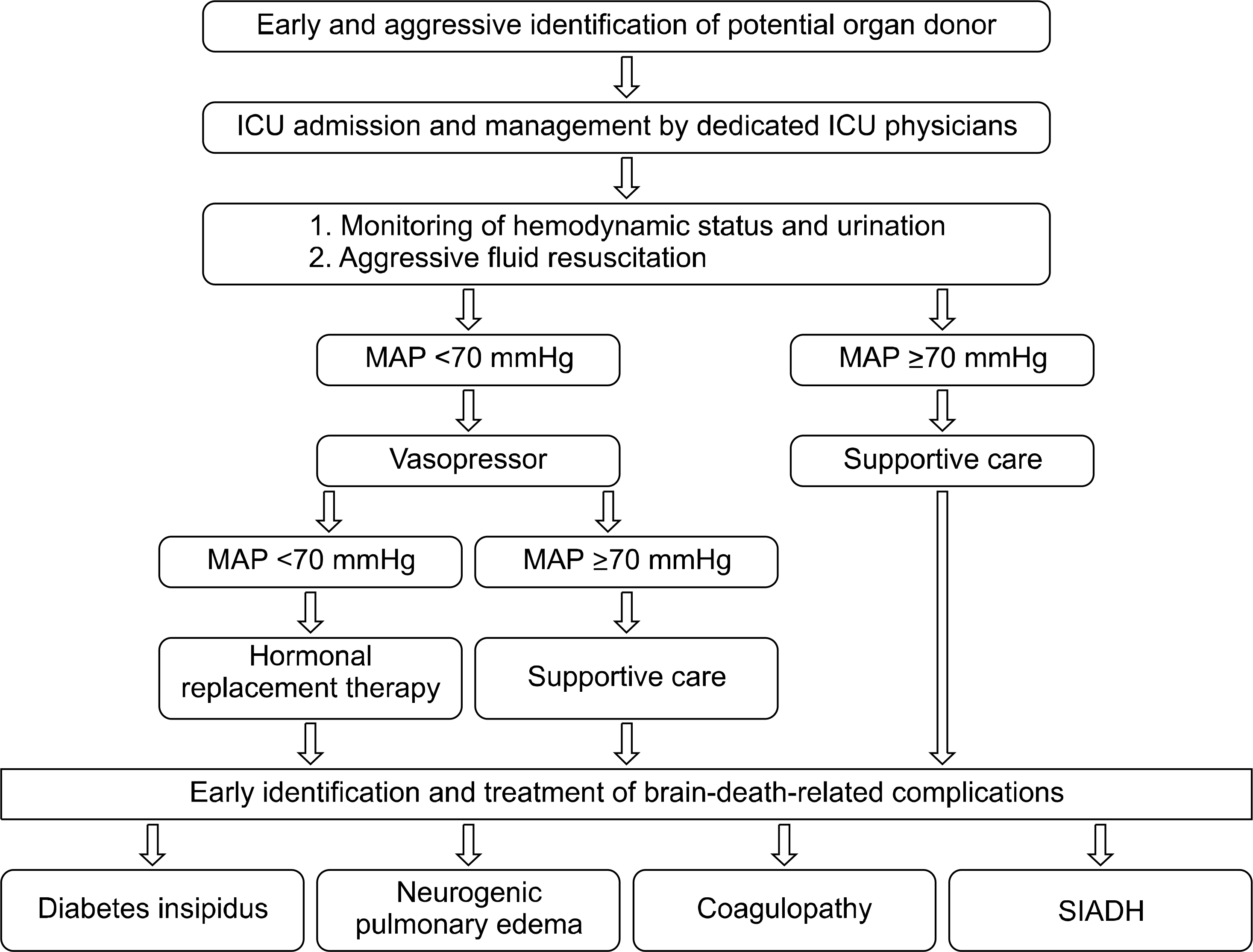J Korean Soc Transplant.
2014 Jun;28(2):51-58. 10.4285/jkstn.2014.28.2.51.
Management and Evaluation Prior to Transplantation of Deceased Donor
- Affiliations
-
- 1Department of Internal Medicine, Research Institute of Clinical Medicine of Chonbuk National University-Biomedical Research Institute of Chonbuk National University Hospital, Chonbuk National University Medical School, Jeonju, Korea. kidney@jbnu.ac.kr
- KMID: 2202531
- DOI: http://doi.org/10.4285/jkstn.2014.28.2.51
Abstract
- The number of people awaiting organ transplantation continues to exceed the number of organs available for transplantation, especially at a time when kidney transplantation is recognized as the best treatment option for end stage renal disease. There may be many reasons for this disparity of organ supply and demand, including the lack of consent, absence of an experienced coordinator team to help in closing the widening gap between organ supply and demand, and an unstandardized critical care management of potential organ donors. According to the report of the Korean Organ Transplant Registry in March 2014, due to a serious organ shortage in Korea, kidneys of deceased donors with low initial estimated glomerular filtration rate of <45 mL/min/1.73 m2 (21.2%) and expanded criteria donors (18.3%) are frequently used, and the number of wife donors and ABO-incompatible transplants for blood type O recipients is increasing. Because the number of donor organs compared with the demand is very restricted, proper management of deceased donors in the intensive care unit has been recognized as a critical determinant for a successful transplantation. Therefore, for successful transplantation of harvested organs, many medical doctors who play an integral role in the transplantation process should understand the pathophysiology of brain death-related systemic changes and well-designed management guidelines should be used prior to transplantation of deceased donors. This article reports on brain death-related systemic changes and proper management for preservation of function of donor organs.
Keyword
MeSH Terms
Figure
Reference
-
References
1). Korean Network for Organ Sharing (KONOS). The second quarter 2013 transplant statistis [Internet]. Seoul: KONOS;2013. [cited 2013 Nov 20]. Available from:. http://konos.go.kr.2). Ahn C, Koo TY, Jeong JC, Kim M, Yang J, Lee J, et al. Initial report of the Korean Organ Transplant Registry: the first report of national kidney transplantation data. Transplant Proc. 2014; 46:425–30.
Article3). A definition of irreversible coma. Report of the Ad Hoc Committee of the Harvard Medical School to Examine the Definition of Brain Death. JAMA. 1968; 205:337–40.4). Practice parameters for determining brain death in adults (summary statement). The Quality Standards Subcommittee of the American Academy of Neurology. Neurology. 1995; 45:1012–4.5). Johnson LS, Subramanian RM. Brain death and cardiac death: donor criteria and care of deceased donor. Morris PJ, Knechtle SJ, editors. ed,. Kidney transplantation: principles and practice. 7th ed.Edinburgh: Saunders, Elsevier;2014. p. 91–104.6). Kim JG, Yang CW. Management of deceased donor. J Neurocrit Care. 2012; 5:40–3.7). DuBose J, Salim A. Aggressive organ donor management protocol. J Intensive Care Med. 2008; 23:367–75.
Article8). Kim SJ. Organ donor management. J Korean Med Assoc. 2006. 49. ;502–6.
Article9). Gottmann U, Brinkkoetter PT, Bechtler M, Hoeger S, Karle C, Schaub M, et al. Effect of pre-treatment with catecholamines on cold preservation and ischemia/re-perfusion-injury in rats. Kidney Int. 2006; 70:321–8.
Article10). Rosendale JD, Kauffman HM, McBride MA, Chabalewski FL, Zaroff JG, Garrity ER, et al. Hormonal resuscitation yields more transplanted hearts, with improved early function. Transplantation. 2003; 75:1336–41.
- Full Text Links
- Actions
-
Cited
- CITED
-
- Close
- Share
- Similar articles
-
- Current Status of Deceased Donor Organ Recovery and Sharing in Korea
- Liver retransplantation for adult recipients
- Activation Policy for Brain-dead Organ Donation
- Thrombotic microangiopathy, rare cause of deceased donor acute kidney injury: is a donor biopsy necessary before donation?
- Evaluation of the Recipient and Donor in Living Kidney Transplantation




